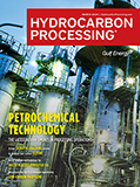Environment & Safety
Fire at Afipsky oil refinery near Novorossiisk put out
A fire that broke out at the Afipsky oil refinery in Russia's Krasnodar region was promptly extinguished, the region's emergency security authorities said after social media reports of powerful blasts shaking the refinery.
Petoskey Plastics receives NOL from FDA for food-contact PCR-LLDPE
Petoskey Plastics has received a No Objection Letter from the U.S. Food and Drug Administration confirming the capability of its secondary recycling process to produce post-consumer recycled linear, low-density polyethylene material that is suitable for food-contact applications.
Technip Energies has complied at all times with applicable sanctions in relation to the Arctic LNG 2 Project
As of February 24, 2022, the date of the invasion of Ukraine, Technip Energies was overseeing the Arctic LNG 2 project in Gydan, northern Russia. The contract, awarded in 2019, covered engineering, equipment procurement and the construction of three LNG trains.
Saudi Aramco CEO: COP28 should focus on cutting fossil fuel emissions, not output
The chief executive of oil giant Saudi Aramco, said on Tuesday this year's COP28 U.N. climate conference should focus on cutting emissions from hydrocarbons, rather than reducing their production.
Discover Clariant’s new Ceridust 8170 M PTFE-free texturing agent for powder coatings
Rising concerns about the impact of PFAS on human health and the environment have led to a growing demand for PTFE alternatives. As part of this trend, Clariant has launched Ceridust 8170 M, a PFAS/PTFE-free agent with texturing effects for Architectural Powder Coatings.
Blast at illegal Nigerian oil refinery kills 37 people
At least 37 people, including two pregnant women, were burned to death after a blast at an illegal oil refinery in southern Nigeria.
Automakers say they face $14 B in fines from Biden's 'unfeasible' fuel rules
The Biden administration proposal to hike fuel economy standards through 2032 is not feasible and could cost automakers a total of more than $14 B in fines.
Beyond sequestration: Changing CO2 from a problem to a solution—Part 2: CO2 as an energy storage medium
As the world continues along its energy transition trajectory, demand for blue hydrogen and reduced carbon emissions will make high-purity carbon dioxide streams available in many process plants.
Implement innovative corrosion management solutions for biofuel refining—Part 2
The production of carbon-neutral and renewable transportation fuels is growing rapidly, driven by the need to find feedstocks beyond fossil resources. Environmental, social and governance (ESG) initiatives—along with accelerated consumer demand for sustainable and carbon-negative fuel products—are also driving demand.
Advanced hydrocracking unit flow scheme optimization and integration approach to maximize refinery margins for a residue upgrading project
The integration of a solvent deasphalting and hydrocracking upgrading complex provides a favorable techno-economic return for residue upgradation at relatively lower capital expenditures vs. other alternatives for a brownfield project.

- India receives fuel oil cargo in Russian SCF tanker after brief halt 4/26
- Biden administration (U.S.) to release SAF tax credit model 4/26
- Boeing, Wagner advance Australia’s SAF Industry 4/26
- S-Oil expects Q2 refining margins to remain steady then trend upward 4/26
- Vitol to charter supertankers from U.S. to Nigeria's Dangote refinery 4/26
- Refiner Valero beats profit estimates on resilient demand, tight supplies 4/26




